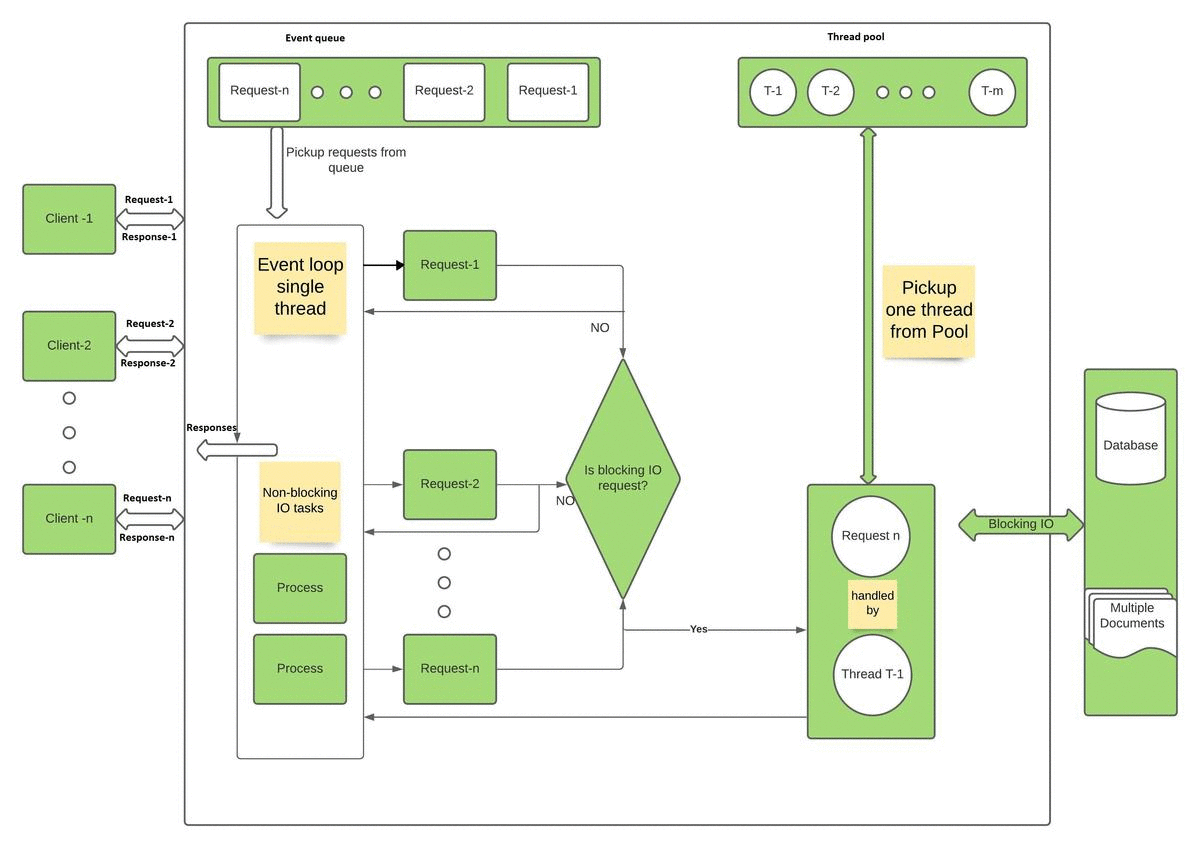Node.js Architecture: The Single-Threaded Event Loop

Node.js has revolutionized backend development with its unique single-threaded event loop architecture. Understanding how Node.js handles concurrency, manages resources, and leverages multi-threading when necessary is essential for building scalable and efficient applications. In this blog post, we'll delve into the intricacies of Node.js architecture, explore its strengths and limitations, and showcase real-world examples of its usage.
Understanding Node.js's Single-Threaded Event Loop:
At its core, Node.js operates on a single-threaded event loop model. This means that a single thread is responsible for handling all incoming requests, I/O operations, and callbacks. Instead of creating a new thread for each request, Node.js utilizes an event-driven approach, where events are processed sequentially in a non-blocking manner.

Let's illustrate this with a simple example:
// Example of an asynchronous operation in Node.js
const fs = require('fs');
// Asynchronous file read operation
fs.readFile('example.txt', 'utf8', (err, data) => {
if (err) {
console.error('Error reading file:', err);
return;
}
console.log('File content:', data);
});
In this example, fs.readFile initiates a file read operation asynchronously. When the operation completes, the provided callback function is executed, allowing the application to continue processing other tasks in the meantime.
Concurrency and Multi-Threading in Node.js:
While Node.js is single-threaded by default, it can leverage multi-threading for CPU-bound tasks using Worker Threads or external services. Worker Threads allow Node.js applications to execute JavaScript code in separate threads, enabling parallelism and offloading CPU-intensive workloads.
// Example of using Worker Threads in Node.js
const { Worker, isMainThread, parentPort } = require('worker_threads');
if (isMainThread) {
// Main thread
const worker = new Worker(__filename);
worker.on('message', (message) => {
console.log('Worker thread message:', message);
});
} else {
// Worker thread
const heavyCalculation = 10 ** 9; // Simulating a CPU-intensive task
parentPort.postMessage(`Result: ${heavyCalculation}`);
}
In this example, the main thread creates a Worker thread to perform a heavy calculation. Once the calculation is complete, the worker thread sends the result back to the main thread using inter-thread communication.
Memory and CPU Utilization in Node.js:
Node.js optimizes memory and CPU utilization through its event-driven, non-blocking architecture. However, it's essential to recognize that CPU-bound operations executed synchronously in the main thread can block the event loop, leading to degraded performance and unresponsiveness.
// Example of CPU-bound operation in Node.js
function fibonacci(n) {
if (n <= 1) {
return n;
}
return fibonacci(n - 1) + fibonacci(n - 2);
}
// CPU-bound operation (fibonacci calculation)
const result = fibonacci(40);
console.log('Fibonacci result:', result);
In the example provided, the fibonacci function performs a CPU-bound operation by recursively calculating the Fibonacci sequence. This operation, being synchronous and computationally intensive, will indeed block the event loop until it completes.
While Node.js excels in handling I/O-bound tasks asynchronously without blocking, it's not inherently optimized for CPU-bound tasks. To ensure optimal performance and responsiveness, CPU-bound tasks should be offloaded to separate threads using techniques like Worker Threads. By leveraging multi-threading for parallel processing, Node.js can efficiently utilize CPU resources without compromising responsiveness or performance.
Advantages of Node.js's Single-Threaded Architecture:
- Scalability: Despite being single-threaded, Node.js is highly scalable due to its non-blocking I/O operations. It can handle thousands of concurrent connections efficiently, making it well-suited for real-time applications like chat servers and streaming platforms.
- Reduced Overhead: Traditional multi-threaded systems incur overhead from context switching and thread management. In contrast, Node.js eliminates this overhead by utilizing a single thread for handling requests, resulting in improved performance and resource utilization.
- Simplified Development: The event-driven nature of Node.js simplifies the development process by allowing developers to write code in a synchronous style while leveraging asynchronous operations under the hood. This makes it easier to reason about code and reduces the likelihood of race conditions and deadlocks.
Comparing Node.js with Java and C#:
While Node.js's single-threaded architecture offers advantages in terms of simplicity and scalability, Java and C# excel in CPU-bound tasks and parallel processing. Java's multi-threaded model, for instance, provides robust concurrency support through thread pools and synchronization primitives. However, it also entails overhead and complexity in thread management.
- Thread Management Overhead: Java's multi-threaded model requires careful management of threads, leading to increased complexity and overhead, especially in scenarios with a high volume of concurrent connections.
- Concurrency Bugs: Writing concurrent code in Java can be challenging due to the potential for race conditions, deadlocks, and synchronization issues. Developers must carefully synchronize access to shared resources to avoid data corruption and inconsistencies.
- Resource Consumption: Each thread in a Java application consumes memory and system resources, limiting the scalability of the system, especially under heavy loads.

Conclusion:
Node.js's single-threaded event loop architecture presents a unique approach to concurrency management, leveraging JavaScript's asynchronous nature to deliver high scalability and performance. While Java and C# shine in CPU-bound tasks and parallel processing, Node.js emerges as a compelling choice for I/O-bound applications.
By comprehending the underlying principles and trade-offs of Node.js's architecture, developers can make informed decisions when selecting the appropriate technology stack for their projects, ensuring optimal performance and scalability.



Comments ()